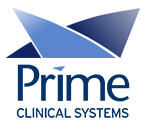
CHARGES MENU OPTIONS

Epogen Encounter
This menu option is used to post additional claim information needed to process a patient claim. Most fields on this screen are used primarily for electronic claims submission.
When there is a physician-administered drug as part of a claim, an NDC code, a quantity, a Unit of Measure, and measurement values are required. See the document on Epogen posting for more details.
See instructions to add Epogen encounter information to a patient’s account.
Updates:
Effective version 16.05.20
In prior versions, for the Internal Control Number (ICN) to be included in the Electronic Claims, the ICN had to be entered in the <Internal Control> field. Effective this version, Intellect now pulls the ICN number from the charge. This is handled by Intellect when auto-posting is used to post payments from the payers. This modification is NOT retroactive. Additionally, this ICN now also prints on the printer EOB from Intellect.
Effective version 14.07.01
When Intellect looks for a Referring Provider (a.k.a. ordering physician), Intellect first looks at the encounter screen for either <Ordering Provider> or <Supervising Provider> and, when either is blank, Intellect looks at the Utility --►Set Up --►Parameter <Referring> setting and pulls the referring provider based on the setting.
Effective Version 9.12.27
For clients who complete most of the Encounter screen fields with the same values for each patient, version 9.12.27 allows a 'default' record to be set up with the value to be carried over to all new Encounters.
To set up a default screen, go to Charges --►Encounter. Select the type of Encounter screen the office uses (the sample below is for Generic Encounter), then select Modify. At the <Patient Account No> field, enter 0 (zero). At the <Encounter #> field, enter 0 (zero).

Complete any field to default to all new Encounters entered.
Setting up the default encounter screen does NOT affect any encounters already entered.
1. To add Epogen encounter information to a patient’s account in Intellect, go to Charges --► Encounter --►Epogen --►Add
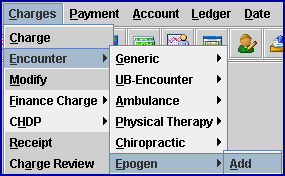
The Add Epogen screen displays:
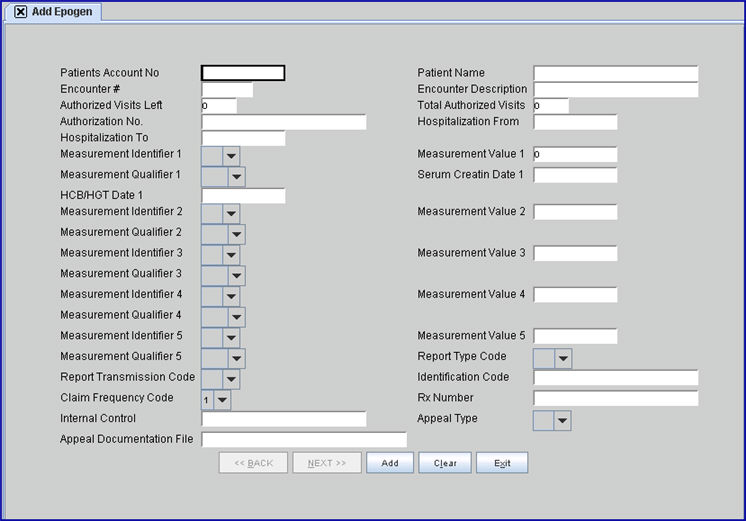
This screen, like many in Intellect has several optional fields. The graphics in this documentation may vary slightly from actual clinics. See the options for this screen and/or the documentation on adding/removing fields.
2. Patients Account No 
2.1 When not already displayed, type the patient’s account number.
2.2 Enter the account number, OR type up to 6 characters of the last name and press the [F2] key. To select the code from the list, either highlight the record and press the [Enter] key, OR double-click on the record.
3. Patients Name 
3.1 The patient’s name is displayed. This is a read-only field and may not be accessed.
3.2 The display is formatted Last, First.
4. Encounter # 
4.1 This number is assigned automatically when adding a new record.
4.2 This number is used to individually identify and display this encounter.
5. Encounter Description 
5.1 Type a meaningful description for this encounter.
6.1 This is an informational field. Enter the <Total Authorized Visits> minus the number of visits that have taken place.
6.2 This value is displayed in the Charges --► Charge <Visit No> field.
7. Total Authorized Visits 
7.1. This is an informational field. Enter the total visits as authorized by the insurer.
8.1 Type the authorization number given by insurer for this treatment.
8.2 Intellect completes Box 23 HCFA (CMS 1500) with this number.

Or, it is used for electronic claims submission Loop 2300 REF01 G1.
9.1 This is used for either paper or electronic claim submission. It is required on all ambulance claims/encounters when the patient was known to be admitted to the hospital. It is also required on inpatient medical visits claims/encounters.
9.2 Type the admit date of the patient, if hospitalized.
9.3 Intellect completes Box 18 HCFA (CMS 1500) with this date. Or, when sent electronically, Loop 2300 DTP*435*D8*.
10.1 This is used for either paper or electronic claim submission. It is required on all ambulance claims/encounters when the patient was known to be admitted to the hospital. It is also required on inpatient medical visits claims/encounters.
10.2 Type the discharge date of the patient if hospitalized.
10.3 Intellect completes Box 18 HCFA (CMS 1500) with this date. Or, when sent electronically, Loop 2300 DTP*096*D8*.

11.1 This field is used in electronic claims submission. It is required on service lines which bill/report the following: Concentration, Hemoglobin, Hematocrit, Epoetin Starting Dosage, Creatin, and Oxygen. It fills Loop 2400 MEA01.
11.2 From the drop-down list, select the type of measurement that applies to <Measurement Value 1> (below):

NOTE: Epoetin starting dosage, in MEA-02. OG is only valid when reported with R3. When sending test results, the qualifier 'TR', test results should reflect a measurement qualifier, other than R3 (Epoetin starting dosage).
12.1 This field is used in electronic claims submission, Loop 2400 MEA03.
12.2 Enter the value of the measurement that applies to <Measurement Qualifier 1> below.
The test results should be entered as follows: TR = test results, R1=hemoglobin or R2=hematocrit (a 2-byte alpha-numeric element), and the most recent numeric test result (a 3-byte numeric element, decimal implied [xx.x]). Results exceeding 3-byte numeric elements (10.50) are reported as 10.5..
Examples: If the most recent hemoglobin test results are 10.50, providers should enter: TR/R1/10.5, or, if the most recent hematocrit results are 32.3, providers would enter: TR/R2/32.3.
13.1 This is used in electronic claims submission in Loop 2400 MEA02.
13.2 This is required on service lines for Dialysis for ESRD. Use R1, R2, R3, or R4 to qualify the Hemoglobin, Hematocrit , and Epoetin Starting Dosage and Creatinine test results.
13.3 Select the code identifying a specific product or process characteristic to which a measurement applies.
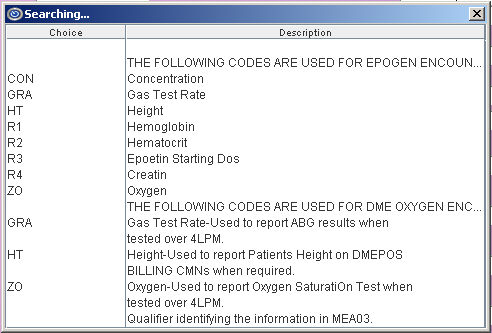
14.1 This is used in electronic claims submission. It is required on initial EPO claims service lines where test results are being billed/reported, Loop 2400 DTP*739
14.2 Enter the Most Recent Serum Creatin test date.
15.1 This is used in electronic claims submission. It is required on initial EPO claims service lines where test results are being billed/reported, Loop 2400 DTP*738
15.2 Use the most recent Hemoglobin or Hematocrit test date or both.
16. Measurement Identifier 2 
16.1 This is used in electronic claims submission.
16.2 From the drop-down list, select the type of measurement that applies to <Measurement Value 2> (below):

17. Measurement Value 2 
17.1 This is used in electronic claims submission.
17.2 Enter the value of the measurement that applies to <Measurement Qualifier 2> below.
18. Measurement Qualifier 2 
18.1 This is used in electronic claims submission.
18.2 This is required on service lines for Dialysis for ESRD . Use R1, R2, R3, or R4 to qualify the Hemoglobin, Hematocrit, and Epoetin Starting Dosage and Creatinine test results.
18.3 Select the code identifying a specific product or process characteristic to which a measurement applies.

19. Measurement Identifier 3 
19.1 This is used in electronic claims submission.
19.2 From the drop-down list, select the type of measurement that applies to <Measurement Value 3> (below):

20. Measurement Value 3 
20.1 This is used in electronic claims submission.
20.2 Enter the value of the measurement that applies to <Measurement Qualifier 3> below.
21. Measurement Qualifier 3 
21.1 This is used in electronic claims submission.
21.2 This is required on service lines for Dialysis for ESRD. Use R1, R2, R3, or R4 to qualify the Hemoglobin, Hematocrit, and Epoetin Starting Dosage and Creatinine test results.
21.3 Select the code identifying a specific product or process characteristic to which a measurement applies.

22. Measurement Identifier 4 
22.1 This is used in electronic claims submission.
22.2 From the drop-down list, select the type of measurement that applies to <Measurement Value 4> (below):

23. Measurement Value 4 
23.1 This is used in electronic claims submission.
23.2 Enter the value of the measurement that applies to <Measurement Qualifier 4> below.
24. Measurement Qualifier 4 
24.1 This is used in electronic claims submission.
24.2 This is required on service lines for Dialysis for ESRD. Use R1, R2, R3, or R4 to qualify the Hemoglobin, Hematocrit, and Epoetin Starting Dosage and Creatinine test results.
24.3 Select the code identifying a specific product or process characteristic to which a measurement applies.

25. Measurement Identifier 5 
25.1 This is used in electronic claims submission.
25.2 From the drop-down list, select the type of measurement that applies to <Measurement Value 5> (below):

26. Measurement Value 5 
26.1 This is used in electronic claims submission.
26.2 Enter the value of the measurement that applies to <Measurement Qualifier 5> below.
27. Measurement Qualifier 5 
27.1 This is used in electronic claims submission.
27.2 This is required on service lines for Dialysis for ESRD. Use R1, R2, R3, or R4 to qualify the Hemoglobin, Hematocrit, and Epoetin Starting Dosage and Creatinine test results.
27.3 Select the code identifying a specific product or process characteristic to which a measurement applies.

28.1 This field is used to designate a supplemental report type that is forwarded separately. It works with the <Report Transmission Code> and <Identification Code> fields. It is included in electronic claims submission Loop 2300 PWK02.
28.2 To view the list of codes with descriptions press the [F2] key. To view the list of only the codes either click on the arrow, OR press the → (right arrow) on the keyboard.
To select, double-click on the correct code, OR use the ↑ (up) and ↓ (down) arrows to highlight the correct code, and then press the [Enter] key to select.
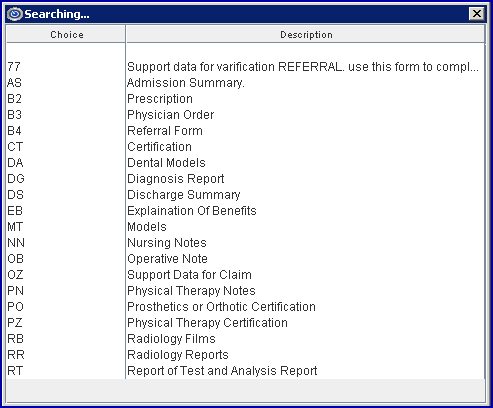
29.1 This field is used to designate a supplemental report type that is forwarded separately. It works with the <Report Type Code> and <Identification Code> fields. It is included in electronic claims submission Loop 2300 PWK02.
29.2 To view the list of codes with descriptions press the [F2] key. To view the list of only the codes either click on the arrow, OR press the → (right arrow) on the keyboard.
To select, double-click on the correct code, OR use the ↑ (up) and ↓ (down) arrows to highlight the correct code, and then press the [Enter] key to select.

30.1 This is used in electronic claims submission. Used for electronic billing. Electronic claims submission Loop 2300 PWK06.
30.2 Type the Attachment Control Number from the pre-printed MEDI-CAL CLAIM Attachment Control Form. The form must accompany the supporting documentation.
NOTE: When completing the encounter record, it is recommended to include the ATTACHMENT CONTROL NUMBER as part of the Encounter Description.
30.3 Effective version 14.07.01, for PCM users only:
30.3.1 With the focus in this field, press the [F2] key twice to display a list of document files pulled from the Progress Notes in PCM (the list does NOT include files generated in Intellect or manually saved to the /home/staff/EB_ATTACHMENT folder).
30.3.2 To display only a certain type of file, enter the beginning letters of the file and then press [F2].
30.3.3 Click on the appropriate file to select it. Multiple files may be selected by holding down the [Ctrl] and [Shift] keys while clicking on the desired files. The file's Document Id displays.
31.1 The Claim Frequency Code is used only for electronic claims submission Loop 2300 CLM05 - 3, and indicates what type of claim it is. For example, an original submission, corrected claim which is being resubmitted, a replacement claim, or a voided claim. The default is set to ‘1': Original Submission. Prior to adding this field on the Encounter screen, the system submitted all claims with Claim Frequency Code 1.
31.2 To view the list of codes with descriptions press the [F2] key. To view the list of only the codes either click on the arrow, OR press the → (right arrow) on the keyboard.
To select, double-click on the correct code, OR use the ↑ (up) and ↓ (down) arrows to highlight the correct code, and then press the [Enter] key to select.

31.3 When making an appeal for a Worker's Comp claim, in addition to this field, the <Internal Control>, <Appeal Type>, and <Appeal Documentation File> fields MUST be filled.
31.4 Effective version 18.08.31: When this field is set greater than 1 and the <Internal Control> field is blank, the ICN # that comes with the ERA file is printed in Box 22 on the HCFA 1500 and also sent electronically.
32. Rx Number 
32.1 Enter the unique identification number assigned by the pharmacy or supplier to the prescription.
33.2 When this encounter is attached to a claim where there is a Utility --► Procedure <Status> = 'N' this number is used in Loop 2410 REF02 with the Qualifier XZ.
33.1 EDS assigns each claim an Internal Control Number (ICN) systematically when it is received electronically or by mail. Processing or returning the claim constitutes EDS’ final action on that claim. A resubmission of the same service is considered a new claim. Each claim sent to EDS is assigned an ICN automatically, which is used to track the claim. The ICN is made up of 13 digits in a specific format. The format of the ICN enables the determination of when the EDS actually received the claim.
33.2 This is used when rebilling a corrected claim to provide the insurance the original claim control number on a denied claim.
33.3 This number is included in the electronic transmission for all claims. It is a number assigned by the payer to identify a claim. The number is usually referred to as an Internal Control Number (ICN), Claim Control Number (CCN), or a Document Control Number (DCN). CLM, 2300 REF02 is the Loop and segment:
CLM*1.608.1.491.G*250***11:B:7*Y*A*Y*Y*P
REF*F8*20024E011000 ß
33.4 When making an appeal for a Worker's Comp claim, in addition to this field, the <Claim Frequency Code>, <Appeal Type>, and <Appeal Documentation File> fields MUST be filled.
33.5 Effective version 18.08.31: When this field is blank and the <Claim Frequency Code> field is set greater than 1, the ICN # that comes with the ERA file is printed in Box 22 on the HCFA 1500 and also sent electronically.
34.1 This field is used to identify the level of the appeal, if needed.
34.2 Use the drop-down list and select the appropriate option:

34.3 When making an appeal for a Worker's Comp claim, in addition to this field, the <Claim Frequency Code>, <Internal Control>, and <Appeal Documentation File> fields MUST be filled.
35.1 If there is documentation that needs to be sent to the insurance company, enter the file name of the documentation.
35.2 Files with valid file names are sent directly to the insurance company.
35.3 Effective version 14.07.01:
Clients with Intellect only:
35.3.1 Create and save Appeal Document(s) files in the /home/staff/EB_ATTACHMENT folder. SBRs may also be saved as a .pdf to the /home/staff/EB_ATTACHMENT folder and attached as appeal documents.
35.3.2 Type the exact file name in this field. Note: This field is case-sensitive.
Clients with both Intellect and Patient Chart Manager (PCM) only:
35.3.3 With the focus in this field, press the [F2] key twice to display a list of document files pulled from the Progress Notes in PCM (the list does NOT include files generated in Intellect or manually saved to the /home/staff/EB_ATTACHMENT folder).
35.3.4 To display only a certain type of file, enter the beginning letters of the file and then press [F2].
35.3.5 Click on the appropriate file to select it. Multiple files may be selected by holding down the [Ctrl] and [Shift] keys while clicking on the desired files. The file's Document Id displays.
35.4 When making an appeal for a Worker's Comp claim, in addition to this field, the <Claim Frequency Code>, <Internal Control>, and <Appeal Type> fields MUST be filled.
36. When the information is completely entered, select one of these options:

36.1 Click [Add] to clear the screen and return the focus to <Patient Account No>, saving the new encounter.
36.2 Click [Clear] to display this message:

36.2.1 Click [Yes] to clear the screen and return the focus to <Patient Account No>, saving the new encounter.
36.2.2 Click [No] to clear the screen and return the focus to <Patient Account No> without saving.
36.3 Click [Exit] to display this message:

36.3.1 Click [Yes] to clear the screen and return the focus to the main Intellect screen, saving the new encounter.
36.3.2 Click [No] to clear the screen and return the focus to the main Intellect screen without saving.